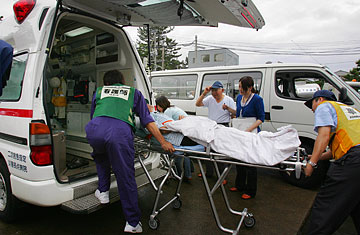
A patient is put into an ambulance after an earthquake in Japan
In the late evening of Jan. 20, an elderly man bicycling in Itami, a town outside Osaka, Japan, collided with a motorcyclist. After receiving first aid from the rescue workers who arrived on the scene, the 69-year-old was refused by 14 hospitals, citing a lack of doctors or resources to handle his case, as he was driven around in an ambulance. Three hours later, after he was finally admitted to one facility, the man died of hemorrhagic shock.
While the case is hardly typical, incidents like it have become all-too frequent as Japan's overburdened health care system grapples with the demands of an aging population. On average, Japanese hospitals deny care to one in six ambulatory call patients, according to the Fire and Disaster Management Agency of the Ministry of Internal Affairs and Communications. And as the need for emergency transportation increases throughout the country, the cases only seem to be adding up.
In recent years, more attention has been drawn to incidents of ambulance patients dying after being turned away by multiple facilities — in one extreme case, 50 — causing an outcry from the public and politicians and underscoring the fact that medical care in world's second largest economy is severely handicapped by lack of capacity, equipment and expertise.
The case list is not pretty. In August 2007, a pregnant woman was refused admission by nine hospitals in a rural part of western Japan, even after miscarrying in the ambulance. In October 2008, another woman was denied by eight hospitals; she was eventually admitted, but three days after giving birth and undergoing surgery, she died. The following month, an 82-year old woman was refused by five hospitals in her hometown, and died en route to a hospital in another city. In 2007, the percentage of cases that require immediate medical attention within total emergency transportation for the year was 11% for the general population, 1% for maternal cases, and 8% for children. "These [numbers] are not high," says James Kondo, president and vice chairman of Health Policy Institute, Japan, a Tokyo-based healthcare think-tank, "but when things go wrong in these areas, it could be fatal." The number of emergency transportation cases for Japan hit 4.92 million in 2007, and the number of serious emergency cases continues to increase. The problem of handling admission requests is particularly severe in urban areas, such as Tokyo and Osaka, which field about 85% of all ambulatory calls.
As the population of Japan ages — with a peak expected in 2025 when the number of those aged 75 or older will reach 22 million, or about 19% of the projected total population, compared to 13 million today — the situation is not likely to improve anytime soon. The need for emergency transportation jumped 50% between 1996 and 2006, and 108% for the elderly. One solution, Kondo says, is to increase the number of doctors, which, given the fierce competition for medical school slots in Japan, will take time despite the fact that Japan has fewer doctors and nurses than the average developed nation, as ranked by the Organization for Economic Co-operation and Development. "It will take 10-plus years to beef up the emergency ward...before having any impact," says Kondo.
In the meantime, some say the medical hierarchy needs to be shaken up to meet the rising demands. Erika Ogawa, a second year junior resident at Tokyo Metropolitan Toshima Hospital, says that more can be done with medical staff, such as nurses, by increasing their numbers and training them to take on more responsibilities. "A medical professional should be in a position to find a hospital that can do an emergency" treatment, rather than ask ambulance staff — who, she says, are not medical professionals — "to keep making calls in vain." Kondo agrees that allowing trained nurses and paramedics more freedom to act in emergency situations could help. "I'm pretty critical of the fact that doctors have such a monopoly over any kind of diagnosis and treatment," says Kondo. "In this regard, Japan needs to go in the U.S. route to developing more paramedics and develop more capacity, with expert nurses and open up the field."
Minimizing unnecessary emergency calls could also help. So-called "light" and "medium" medical cases fielded by Japan's ambulance system increased by 56% and 58%, respectively, between 1996 and 2006. Last year, Health Minister Yoichi Masuzoe urged communities to help to ease the burden on their hospitals and called for an increase in the number of trained doctors, but his plan has been criticized for lacking specific measures. Child care circles, such as those developed by communities in the Kansai area, are examples of how mothers educate each other on what qualifies as a medical emergency for their children, and what doesn't — a system that could also work for the elderly.
But the pace of change is slow — both inside and outside the medical field. "Even though doctors say they're lacking the absolute numbers, they're protective of their turf and don't want masses of nurses and others taking up their business," says Kondo. "Fundamentally, you're touching on something deeply political in Japan." And unfortunately, it's the people they are trying to help who are paying the price.
